LUCID AIR 2023 Owners Manual
Manufacturer: LUCID, Model Year: 2023, Model line: AIR, Model: LUCID AIR 2023Pages: 241, PDF Size: 5.15 MB
Page 171 of 241

and brake fluid meeting specification
DOT4.
4. Install the reservoir cap.CAUTION: Brake fluid will damage
painted surfaces. Immediately soak up any spills with an absorbent cloth andwash the affected area with a mixture
of car shampoo and water.
Replacing brake
Page 172 of 241
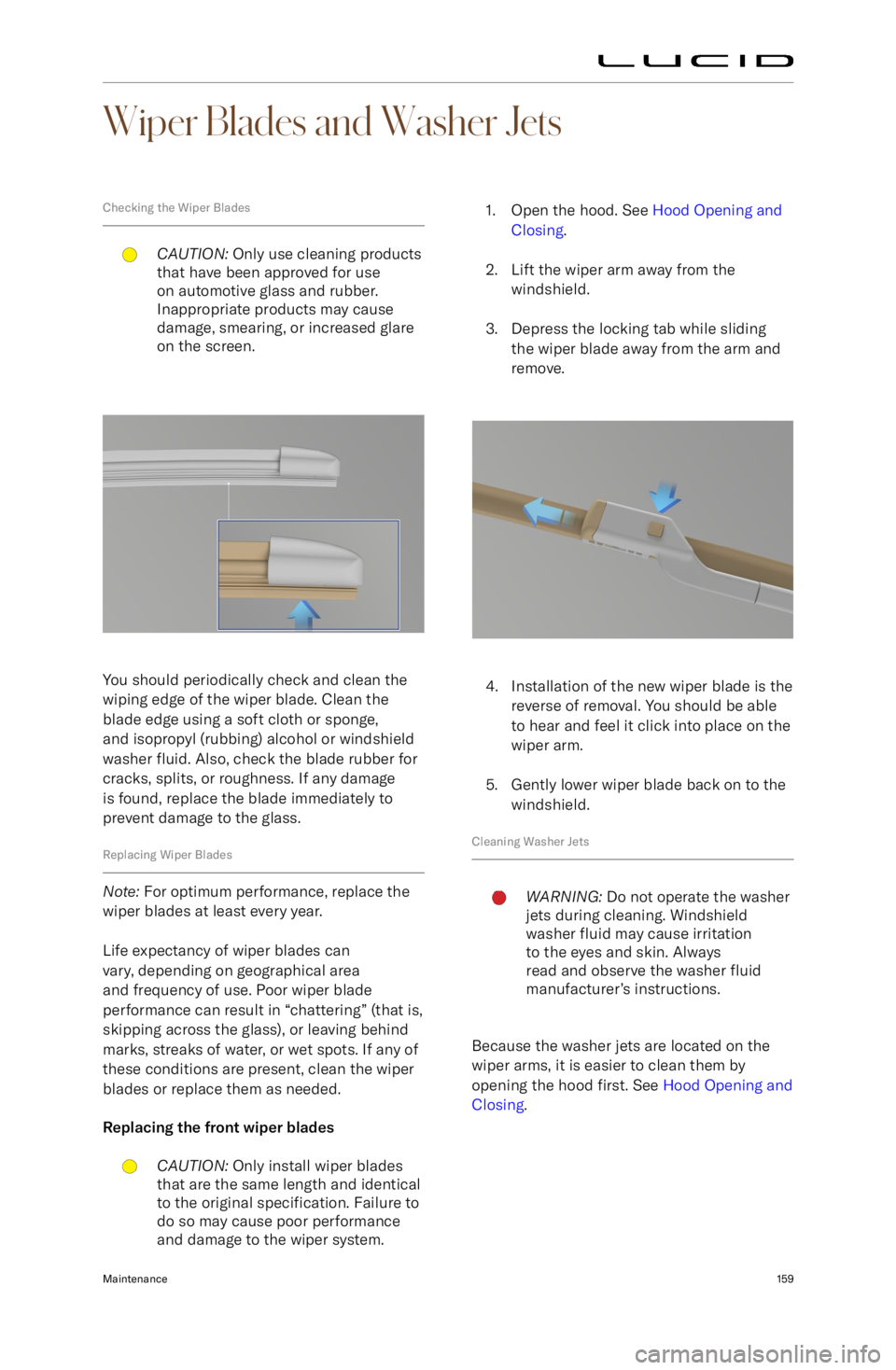
Wiper Blades and Washer Jets
Checking the Wiper BladesCAUTION: Only use cleaning products
that have been approved for use
on automotive glass and rubber.
Inappropriate products may cause
damage, smearing, or increased glare
on the screen.
You should periodically check and clean the
wiping edge of the wiper blade. Clean the blade edge using a soft cloth or sponge,
and isopropyl (rubbing) alcohol or windshield
washer fluid. Also, check the blade rubber for
cracks, splits, or roughness. If any damage
is found, replace the blade immediately to
prevent damage to the glass.
Replacing Wiper Blades
Note: For optimum performance, replace the
wiper blades at least every year.
Life expectancy of wiper blades can
vary, depending on geographical area
and frequency of use. Poor wiper blade
performance can result in “chattering” (that is, skipping across the glass), or leaving behind
marks, streaks of water, or wet spots. If any of
these conditions are present, clean the wiper
blades or replace them as needed.
Replacing the front wiper blades
CAUTION: Only install wiper blades
that are the same length and identical to the original specification. Failure to
do so may cause poor performance and damage to the wiper system.1. Open the hood. See Hood Opening and
Closing .
2. Lift the wiper arm away from the windshield.
3. Depress the locking tab while sliding the wiper blade away from the arm and
remove.
4. Installation of the new wiper blade is the reverse of removal. You should be able
to hear and feel it click into place on the
wiper arm.
5. Gently lower wiper blade back on to the windshield.
Cleaning Washer Jets
WARNING: Do not operate the washer
jets during cleaning. Windshield
washer fluid may cause irritation
to the eyes and skin. Always
read and observe the washer fluid
manufacturer
Page 173 of 241

If a washer jet nozzle becomes clogged
with debris or build-up, its performance can be reduced. There are several methods forremoving any blockage:
-Dip a small, soft-bristled brush (such as
an old toothbrush) in warm water and
scrub in and around the nozzle to clear
away any dirt or debris.
- Use a can of compressed air to blow a
concentrated stream of air into the clog
to loosen it, and to blow away any debris from the nozzle.
- For more serious clogs, slide a thin piece
of wire into the nozzle to clear any
blockages.
Maintenance160
Page 174 of 241
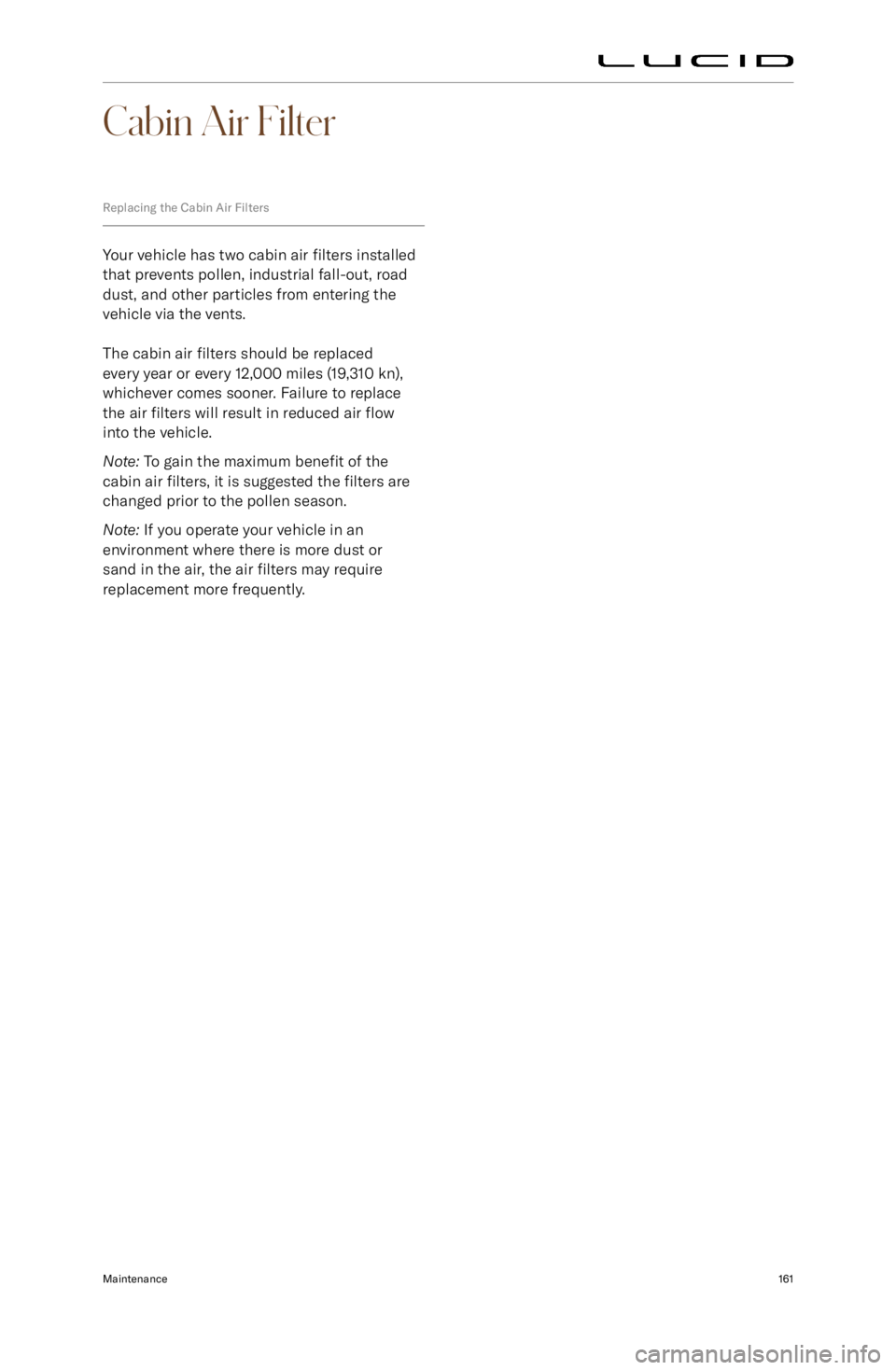
Cabin Air Filter
Replacing the Cabin Air Filters
Your vehicle has two cabin air filters installed
that prevents pollen, industrial fall-out, road
dust, and other particles from entering the vehicle via the vents.
The cabin air filters should be replaced
every year or every 12,000 miles (19,310 kn),
whichever comes sooner. Failure to replace the air filters will result in reduced air flow
into the vehicle.
Note: To gain the maximum benefit of the
cabin air filters, it is suggested the filters are
changed prior to the pollen season.
Note: If you operate your vehicle in an
environment where there is more dust or
sand in the air, the air filters may require
replacement more frequently.
Maintenance161
Page 175 of 241
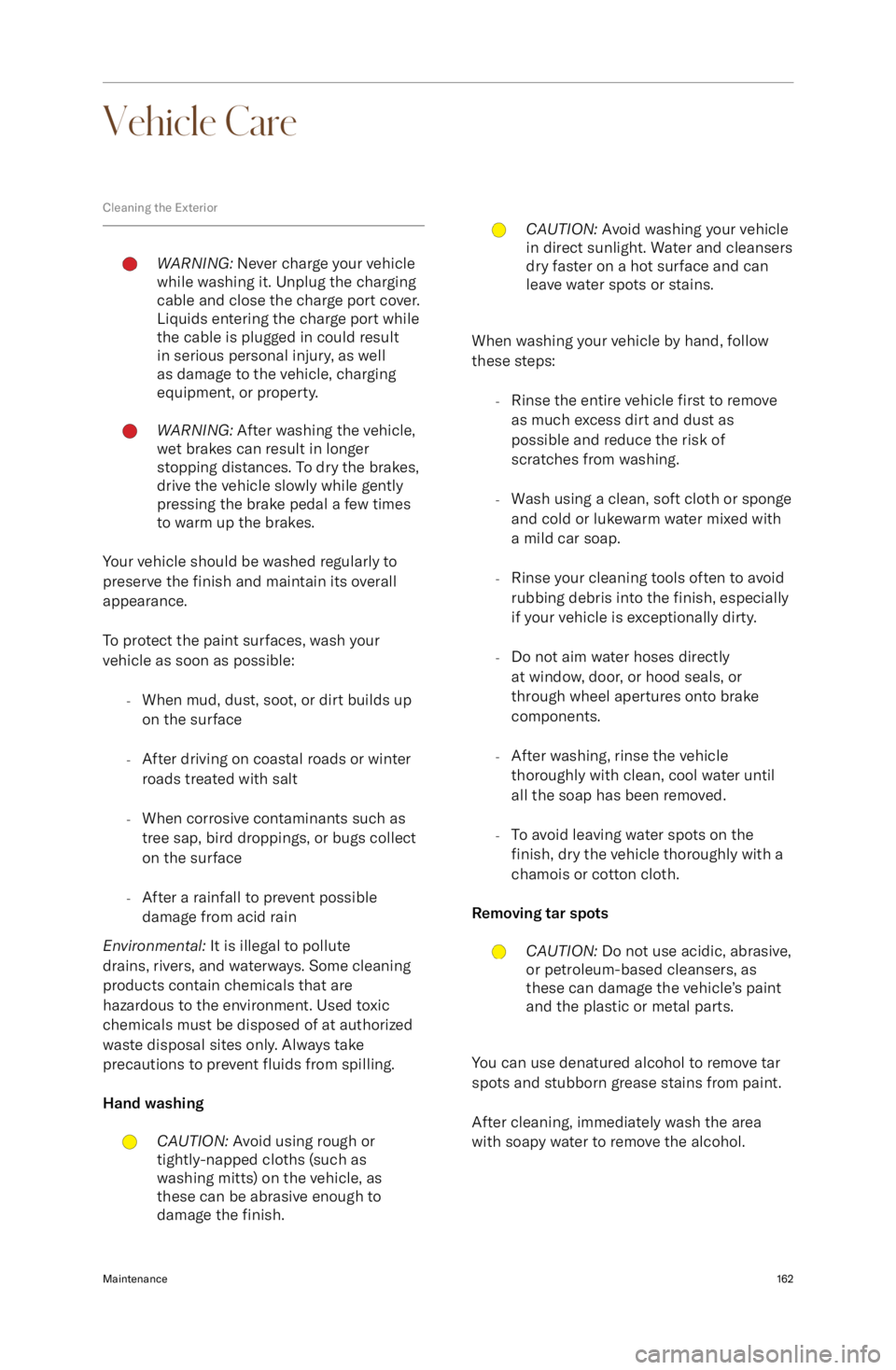
Vehicle Care
Cleaning the ExteriorWARNING: Never charge your vehicle
while washing it. Unplug the charging
cable and close the charge port cover.
Liquids entering the charge port while
the cable is plugged in could result
in serious personal injury, as well
as damage to the vehicle, charging
equipment, or property.WARNING: After washing the vehicle,
wet brakes can result in longer
stopping distances. To dry the brakes,
drive the vehicle slowly while gently
pressing the brake pedal a few times
to warm up the brakes.
Your vehicle should be washed regularly to
preserve the finish and maintain its overall
appearance.
To protect the paint surfaces, wash your
vehicle as soon as possible:
-When mud, dust, soot, or dirt builds up
on the surface
- After driving on coastal roads or winter
roads treated with salt
- When corrosive contaminants such as
tree sap, bird droppings, or bugs collect
on the surface
- After a rainfall to prevent possible
damage from acid rain
Environmental: It is illegal to pollute
drains, rivers, and waterways. Some cleaning
products contain chemicals that are
hazardous to the environment. Used toxic
chemicals must be disposed of at authorized
waste disposal sites only. Always take
precautions to prevent fluids from spilling.
Hand washing
CAUTION: Avoid using rough or
tightly-napped cloths (such as
washing mitts) on the vehicle, as
these can be abrasive enough to
damage the finish.CAUTION: Avoid washing your vehicle
in direct sunlight. Water and cleansers
dry faster on a hot surface and can
leave water spots or stains.
When washing your vehicle by hand, follow
these steps:
-Rinse the entire vehicle first to remove
as much excess dirt and dust as
possible and reduce the risk of
scratches from washing.
- Wash using a clean, soft cloth or sponge
and cold or lukewarm water mixed with
a mild car soap.
- Rinse your cleaning tools often to avoid
rubbing debris into the finish, especially
if your vehicle is exceptionally dirty.
- Do not aim water hoses directly
at window, door, or hood seals, or
through wheel apertures onto brake
components.
- After washing, rinse the vehicle
thoroughly with clean, cool water until
all the soap has been removed.
- To avoid leaving water spots on the
finish, dry the vehicle thoroughly with a
chamois or cotton cloth.
Removing tar spots
CAUTION: Do not use acidic, abrasive,
or petroleum-based cleansers, as
these can damage the vehicle
Page 176 of 241
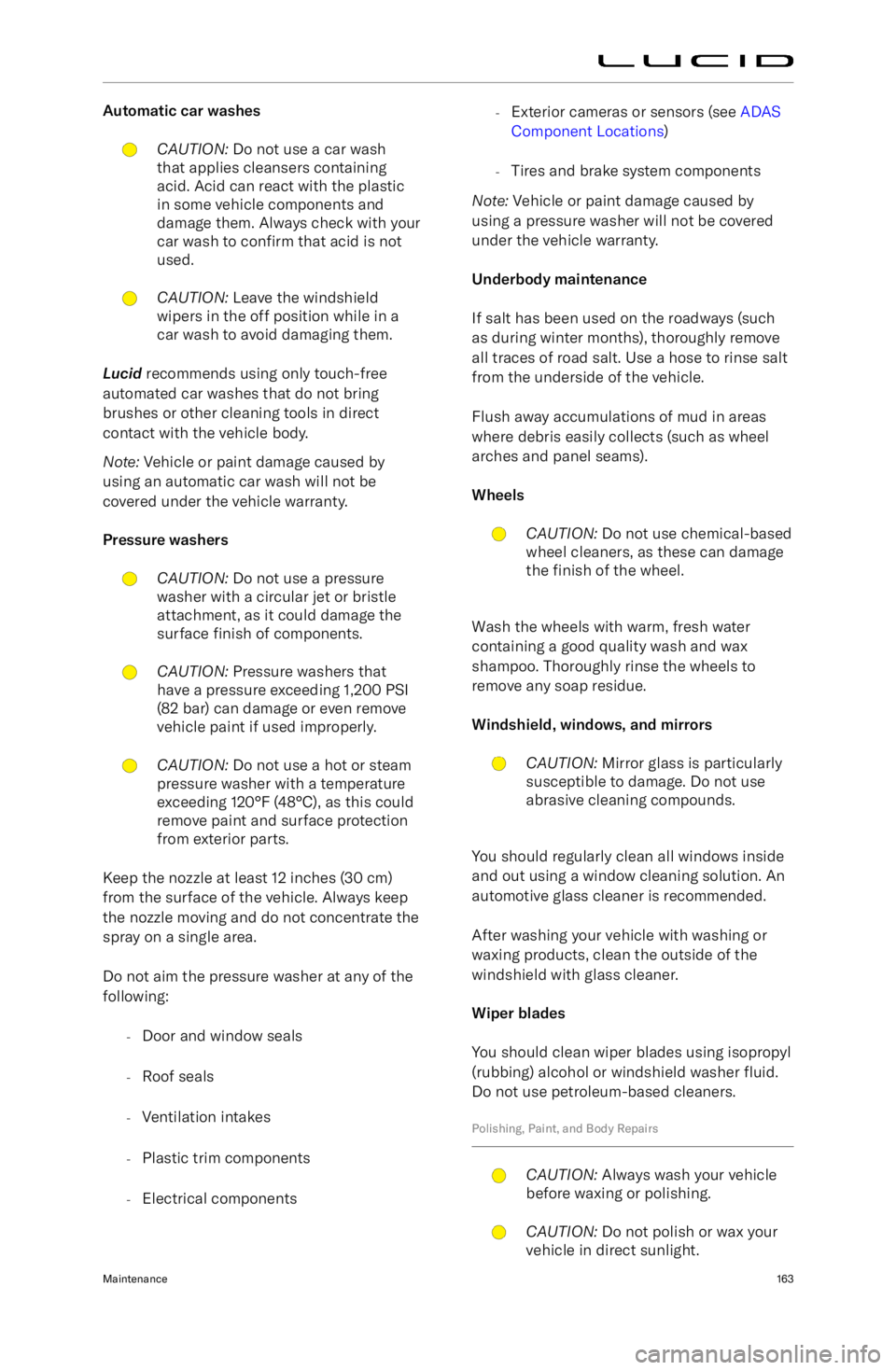
Automatic car washesCAUTION: Do not use a car wash
that applies cleansers containing
acid. Acid can react with the plastic
in some vehicle components and
damage them. Always check with your
car wash to confirm that acid is not
used.CAUTION: Leave the windshield
wipers in the off position while in a car wash to avoid damaging them.
Lucid recommends using only touch-free
automated car washes that do not bring
brushes or other cleaning tools in direct
contact with the vehicle body.
Note: Vehicle or paint damage caused by
using an automatic car wash will not be
covered under the vehicle warranty.
Pressure washers
CAUTION: Do not use a pressure
washer with a circular jet or bristle
attachment, as it could damage the
surface finish of components.CAUTION: Pressure washers that
have a pressure exceeding 1,200 PSI
(82 bar) can damage or even remove
vehicle paint if used improperly.CAUTION: Do not use a hot or steam
pressure washer with a temperature
exceeding 120
Page 177 of 241
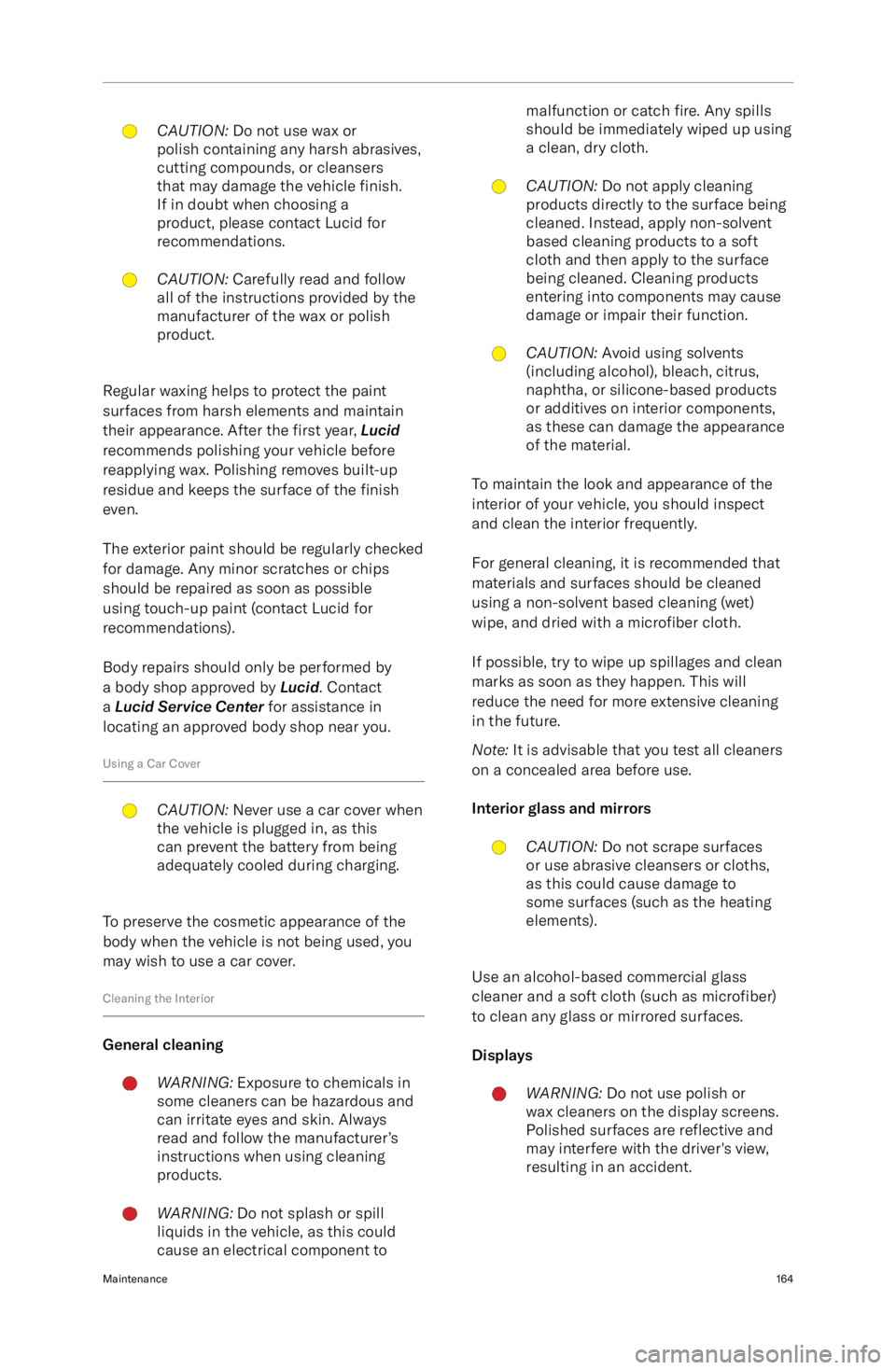
CAUTION: Do not use wax or
polish containing any harsh abrasives,
cutting compounds, or cleansers
that may damage the vehicle finish.
If in doubt when choosing a
product, please contact Lucid for
recommendations.CAUTION: Carefully read and follow
all of the instructions provided by the
manufacturer of the wax or polish
product.
Regular waxing helps to protect the paint
surfaces from harsh elements and maintain
their appearance. After the first year, Lucid
recommends polishing your vehicle before
reapplying wax. Polishing removes built-up
residue and keeps the surface of the finish
even.
The exterior paint should be regularly checked for damage. Any minor scratches or chipsshould be repaired as soon as possible
using touch-up paint (contact Lucid for
recommendations).
Body repairs should only be performed by
a body shop approved by Lucid. Contact
a Lucid Service Center for assistance in
locating an approved body shop near you.
Using a Car Cover
CAUTION: Never use a car cover when
the vehicle is plugged in, as this
can prevent the battery from being
adequately cooled during charging.
To preserve the cosmetic appearance of the
body when the vehicle is not being used, you
may wish to use a car cover.
Cleaning the Interior
General cleaning
WARNING: Exposure to chemicals in
some cleaners can be hazardous and
can irritate eyes and skin. Always
read and follow the manufacturer
Page 178 of 241
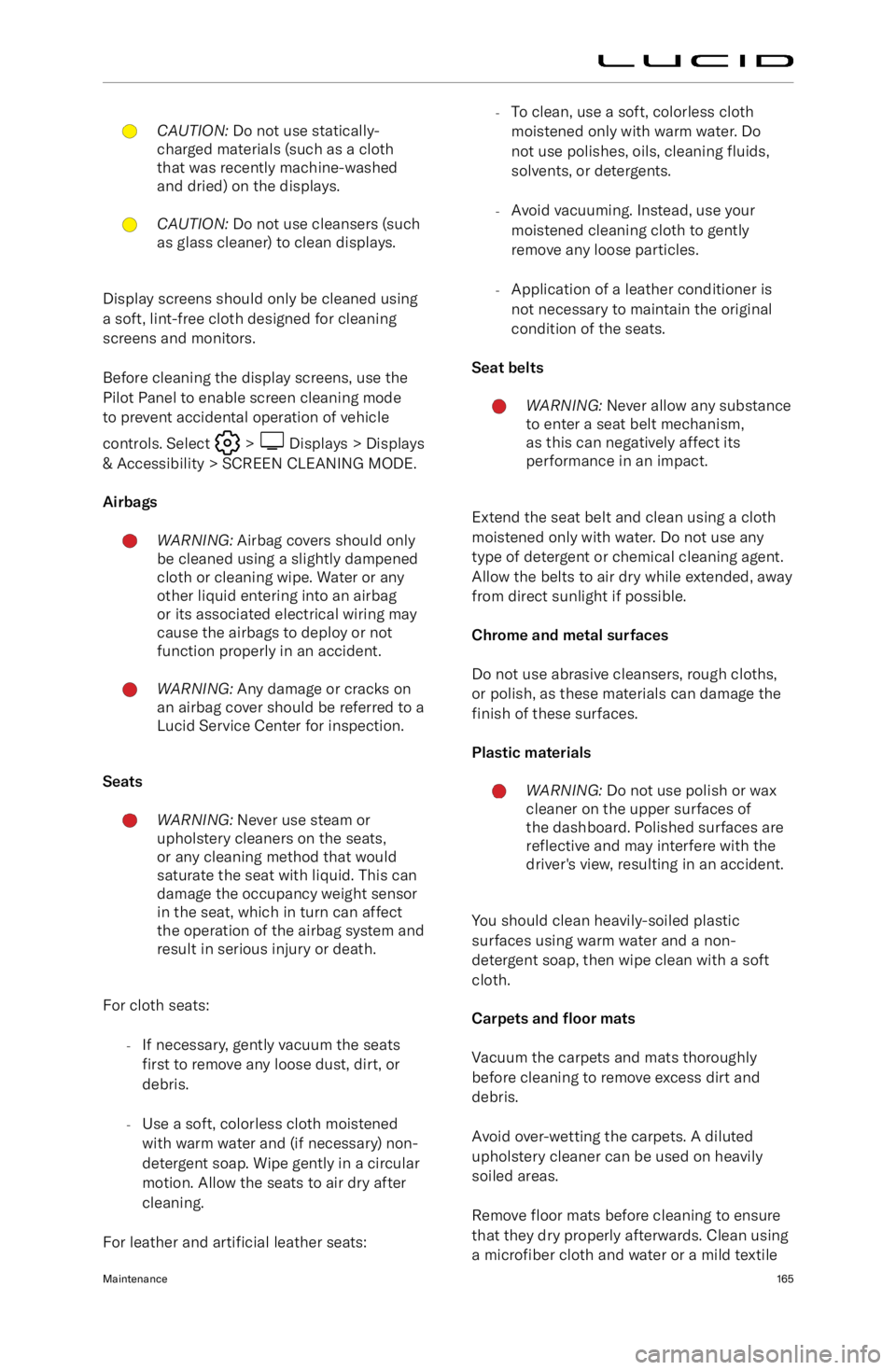
CAUTION: Do not use statically-
charged materials (such as a cloth
that was recently machine-washed
and dried) on the displays.CAUTION: Do not use cleansers (such
as glass cleaner) to clean displays.
Display screens should only be cleaned using
a soft, lint-free cloth designed for cleaning
screens and monitors.
Before cleaning the display screens, use the
Pilot Panel to enable screen cleaning mode
to prevent accidental operation of vehicle
controls. Select
> Displays > Displays
& Accessibility > SCREEN CLEANING MODE.
Airbags
WARNING: Airbag covers should only
be cleaned using a slightly dampened
cloth or cleaning wipe. Water or any
other liquid entering into an airbag
or its associated electrical wiring may
cause the airbags to deploy or not
function properly in an accident.WARNING: Any damage or cracks on
an airbag cover should be referred to a
Lucid Service Center for inspection.
Seats
WARNING: Never use steam or
upholstery cleaners on the seats,
or any cleaning method that would
saturate the seat with liquid. This can
damage the occupancy weight sensor
in the seat, which in turn can affect
the operation of the airbag system and
result in serious injury or death.
For cloth seats:
-If necessary, gently vacuum the seats
first to remove any loose dust, dirt, or
debris.
- Use a soft, colorless cloth moistened
with warm water and (if necessary) non- detergent soap. Wipe gently in a circular
motion. Allow the seats to air dry after
cleaning.
For leather and artificial leather seats:
-To clean, use a soft, colorless cloth
moistened only with warm water. Do
not use polishes, oils, cleaning fluids,
solvents, or detergents.
- Avoid vacuuming. Instead, use your
moistened cleaning cloth to gently
remove any loose particles.
- Application of a leather conditioner is
not necessary to maintain the original
condition of the seats.
Seat beltsWARNING: Never allow any substance
to enter a seat belt mechanism,
as this can negatively affect its
performance in an impact.
Extend the seat belt and clean using a cloth
moistened only with water. Do not use any
type of detergent or chemical cleaning agent.
Allow the belts to air dry while extended, away
from direct sunlight if possible.
Chrome and metal surfaces
Do not use abrasive cleansers, rough cloths,
or polish, as these materials can damage the
finish of these surfaces.
Plastic materials
WARNING: Do not use polish or wax
cleaner on the upper surfaces of the dashboard. Polished surfaces are
reflective and may interfere with the
driver
Page 179 of 241

cleanser. Spot-test any cleansers first to
ensure they will not leave stains. Dry the mat
thoroughly before reinstalling.
Floor MatsWARNING: Loose or improperly fitted
floor mats could interfere with the
operation of the foot pedals, which
could lead to loss of vehicle control
and a collision.WARNING: Do not place additional
floor mats over the existing ones.WARNING: Always install floor mats
with the correct side facing up. Do not
turn them over.
Using genuine Lucid floor mats can extend
the life of your vehicle
Page 180 of 241

Parts and Accessories
Parts, Accessories, and ModificationsWARNING: Lucid does not
recommend installing non-approved
parts and accessories or performing
non-approved vehicle modifications.
Doing so can negatively affect your
vehicle